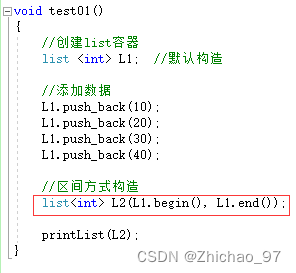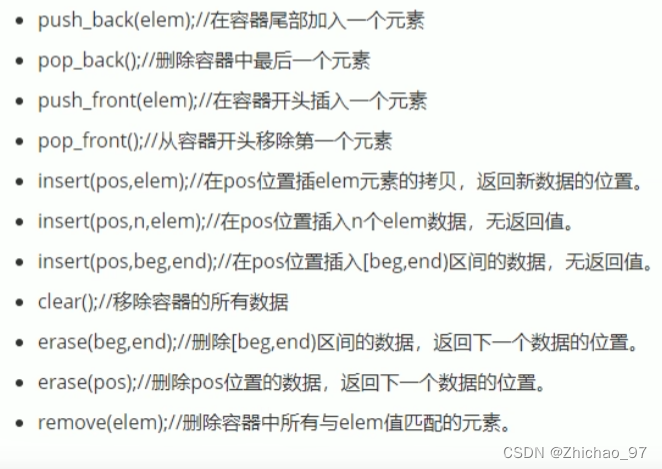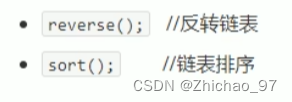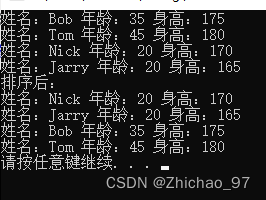1. list基本概念
功能:将数据进行链式存储
链表(list)是一种物理存储单元上非连续的存储结构,数据元素的逻辑顺序是通过链表中的指针链接实现的
链表的组成:链表由—系列结点组成
结点的组成:一个是存储数据元素的数据域,另一个是存储下一个结点地址的指针域
STL中的链表是一个双向循环链表
相对于数组,链表的优点、缺点:
优点:可以对任意位置进行快速插入或删除
缺点:容器遍历速度没有数组快,占用空间比数组大

由于链表的存储方式并不是连续的内存空间,因此链表list中的迭代器只支持前移和后移,属于双向迭代器。
list的优点:
采用动态存储分配,不会造成内存浪费和溢出
链表执行插入和删除操作十分方便,修改指针即可,不需要移动大量元素
list的缺点:
链表灵活,但是空间(指针域)和时间(遍历)额外耗费较大
List有一个重要的性质,插入操作和删除操作都不会造成原有list迭代器的失效,这在vector是不成立的。
总结:STL中List和vector是两个最常被使用的容器,各有优缺点。
2. list构造函数
功能:创建list容器
函数原型:

示例1:(默认构造)
#include<iostream>
using namespace std;
#include<list>
#include<string>
void printList(const list<int> &L)
{
for (list<int>::const_iterator it = L.begin(); it != L.end(); it++)
{
cout << *it << " ";
}
cout << endl;
}
void test01()
{
//创建list容器
list <int> L1; //默认构造
//添加数据
L1.push_back(10);
L1.push_back(20);
L1.push_back(30);
L1.push_back(40);
printList(L1);
}
int main() {
test01();
system("pause");
return 0;
}结果:

示例2:(区间构造)


拷贝构造:
list<int>L3(L2);n个元素:
list<int> L4(10,1000);3. list赋值和交换
功能:给list容器赋值,以及交换list容器
函数原型:
 示例1:(赋值)
示例1:(赋值)
等号赋值:
#include<iostream>
using namespace std;
#include<list>
#include<string>
void printList(const list<int> &L)
{
for (list<int>::const_iterator it = L.begin(); it != L.end(); it++)
{
cout << *it << " ";
}
cout << endl;
}
void test01()
{
//创建list容器
list <int> L1; //默认构造
//添加数据
L1.push_back(10);
L1.push_back(20);
L1.push_back(30);
L1.push_back(40);
list<int> L2;
L2 = L1; //等号赋值
printList(L2);
}
int main() {
test01();
system("pause");
return 0;
}结果:

assign赋值:
list<int> L3;
L3.assign(L1.begin(), L1.end());
printList(L3); 
list<int> L4;
L4.assign(10, 100);
printList(L4);
实例2:(交换)
#include<iostream>
using namespace std;
#include<list>
#include<string>
void printList(const list<int> &L)
{
for (list<int>::const_iterator it = L.begin(); it != L.end(); it++)
{
cout << *it << " ";
}
cout << endl;
}
void test01()
{
//创建list容器
list <int> L1; //默认构造
//添加数据
L1.push_back(10);
L1.push_back(20);
L1.push_back(30);
L1.push_back(40);
list<int> L2;
L2.assign(10, 100);
//交换前
printList(L1);
printList(L2);
//交换后
L1.swap(L2);
printList(L1);
printList(L2);
}
int main() {
test01();
system("pause");
return 0;
}结果:

4. list大小操作
功能:对list容器的大小进行操作
函数原型:

5. list插入和删除
功能:对list容器进行数据的插入和删除
函数原型:

6. list数据存取
功能:对list容器中数据进行存取
函数原型:

L[0] 不可以使用 [] 访问list容器中的元素
L.at(0) 不可以用at方式访问list容器中的元素
原因是list本质链表,不是用连续线性空间存储数据,迭代器也是不支持随机访问的
7. list反转和排序
功能:将容器中的元素反转,以及将容器中的数据进行排序
函数原型:

L.reverse(); //list反转
L.sort(); //list排序8. 排序案例
案例描述:将Person自定义数据类型进行排序,Person中属性有姓名、年龄、身高
排序规则:按照年龄进行升序,如果年龄相同按照身高进行降序
#include<iostream>
using namespace std;
#include<list>
#include<string>
class Person
{
public:
Person(string name, int age, int height)
{
this->m_Name = name;
this->m_Age = age;
this->m_Height = height;
}
string m_Name;
int m_Age;
int m_Height;
};
//指定排序规则
bool comparePerson(Person &p1, Person &p2)
{
if (p1.m_Age == p2.m_Age)
{
//年龄相同,按照升高降序
return p1.m_Height > p2.m_Height;
}
else
{
//按照年龄升序
return p1.m_Age < p2.m_Age;
}
}
void test01()
{
//创建list容器
list <Person> L;
//准备数据
Person p1("Bob", 35, 175);
Person p2("Tom", 45, 180);
Person p3("Nick", 20, 170);
Person p4("Jarry", 20, 165);
//向容器中插入数据
L.push_back(p1);
L.push_back(p2);
L.push_back(p3);
L.push_back(p4);
for (list<Person>::iterator it = L.begin(); it != L.end(); it++)
{
cout << "姓名:" << (*it).m_Name << " 年龄:" << it->m_Age << " 身高:" << it->m_Height << endl;
}
cout << "排序后:" << endl;
//排序
L.sort(comparePerson);
for (list<Person>::iterator it = L.begin(); it != L.end(); it++)
{
cout << "姓名:" << (*it).m_Name << " 年龄:" << it->m_Age << " 身高:" << it->m_Height << endl;
}
}
int main() {
test01();
system("pause");
return 0;
}结果:
